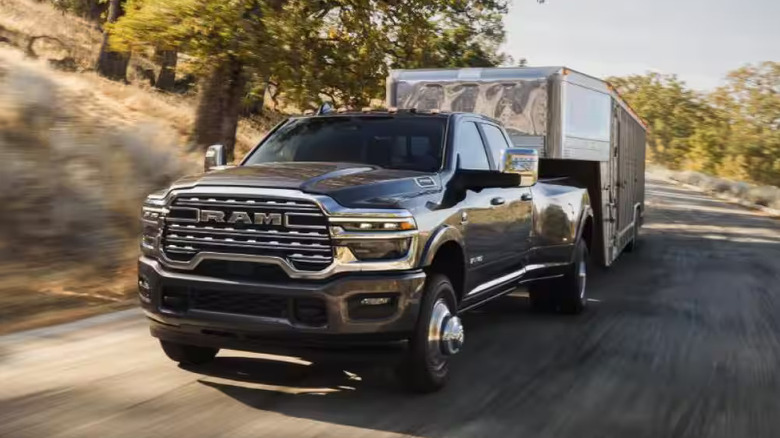Why Cummins Had To Pay Nearly $2B After The EPA Accused It Of Cheating
Cummins is one of the biggest engine manufacturers, building both gas and diesel power plants for trains, commercial vehicles, construction equipment, and even marine vessels. One of its best-known automotive products is the 6.7-liter turbodiesel that has powered Ram's 2500 and 3500 pickups since 2007. But now, that engine and its reputation are being called into question by one of the largest environmental penalties in U.S. history. The Environmental Protection Agency (EPA) and the California Air Resources Board (CARB) accused Cummins of using "defeat devices" in these trucks to cheat emission tests.
The EPA says the defeat device could detect when the trucks were undergoing emission testing and temporarily run its emission control at full strength. Once back on the road, those controls would ease off, which allowed nitrogen oxide (NOx) tailpipe emissions to spike far above what the Clean Air Act allows. NOx is a major pollutant that has been linked to smog, asthma, lung damage, and other major respiratory problems – which is why the penalties were so steep. In total, the settlement climbed up to roughly $2 billion once the initial $1.675 billion fine was combined with the cost of mandatory recalls and pollution offset projects.
This makes it the second-largest environmental fine in U.S. history, second only to BP's Deepwater Horizon Oil Spill disaster, settled in 2015. And if all this sounds familiar, that's because it's straight out of the same playbook Volkswagen used during its now infamous "Dieselgate" scandal — except this time, it hit America's heavy-duty truck market, and raises the same uncomfortable questions about what the recall means for performance, fuel efficiency, and resale value.
The recall will target hundreds of thousands of Ram trucks on U.S. roads
The penalty doesn't stop at the record-setting fine. Under the settlement, Cummins now has to work with Ram dealers to fix the trucks already out there — by issuing a recall covering the affected 630,000 model-year 2013-2019 Ram 2500 and 3500 diesel trucks equipped with a two-sensor selective catalytic reduction (SCR) controller. Beyond that, the settlement gave Cummins three years to repair at least 85% of the recalled trucks.
No hardware changes are required — dealers will reflash the engine control module with new software that keeps emissions controls fully active in everyday driving. It's a free update for owners, available with no set end date, and it comes with an extended warranty covering key components affected by the recall. The EPA and CARB regulators say the update is validated using standard lab tests, and both off- and on-road PEMS testing to make sure NOx emissions stay within the limits set by the Clean Air Act.
Beyond the Ram truck recalls, the EPA demands that Cummins offset its environmental damage, which translates to $175 million to California for NOx-reduction projects, replacing 27 high-emission diesel locomotives nationwide, and funding 50 more locomotive idle-reduction engine upgrades, costing nearly $70 million. The cost for these locomotive upgrades, together with the nationwide truck recall program, is estimated at over $326 million, bringing Cummins' total fine — once the $1.675 billion civil penalty is factored in – to almost $2 billion.
Another 330,000 Ram trucks manufactured between 2019 and 2023 were also found with undisclosed emissions software, but it wasn't the kind that limited pollution controls or caused extra emissions, so they aren't part of the recall. To see if your specific Ram truck is included, use Mopar's VIN lookup once the recall notice arrives.

